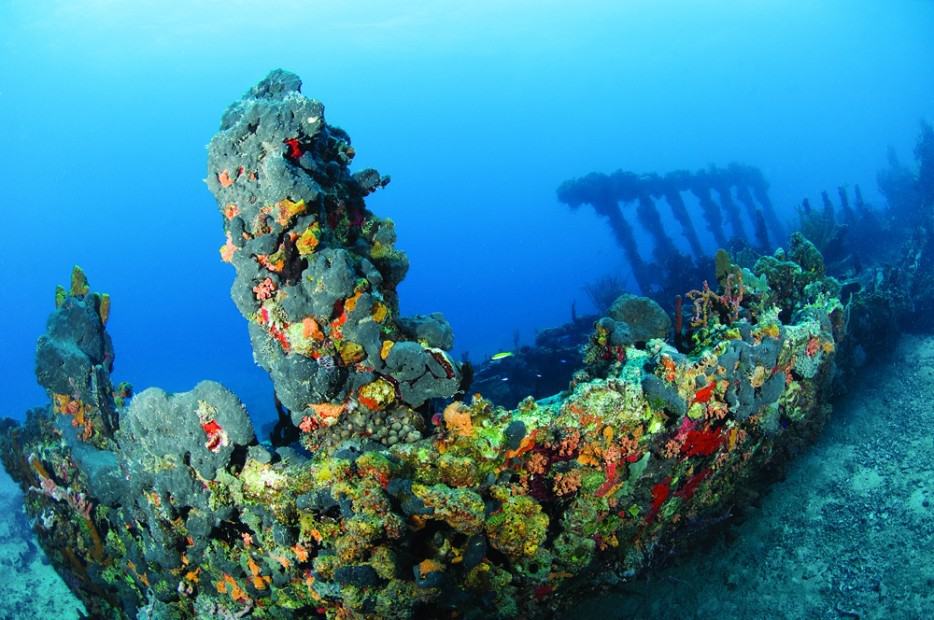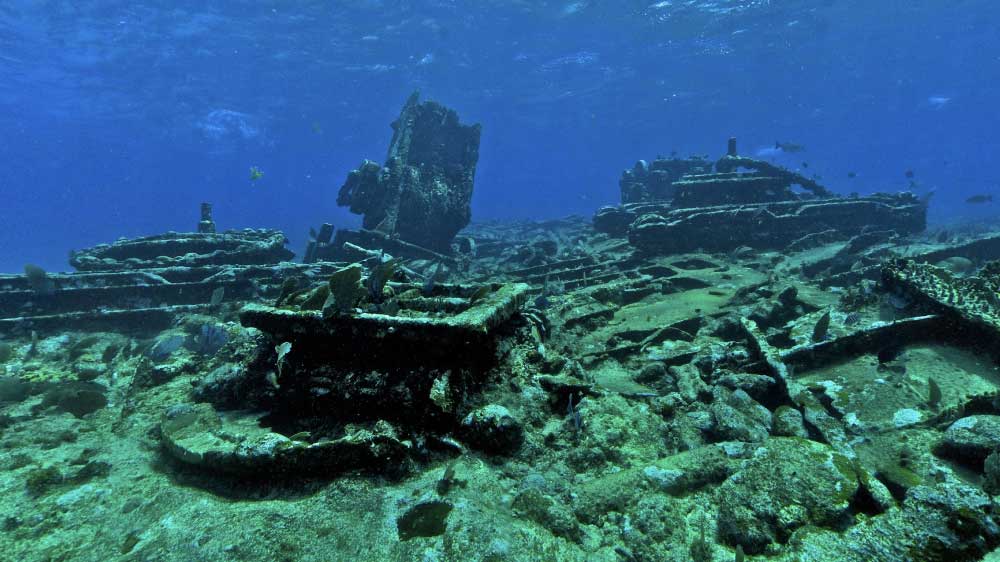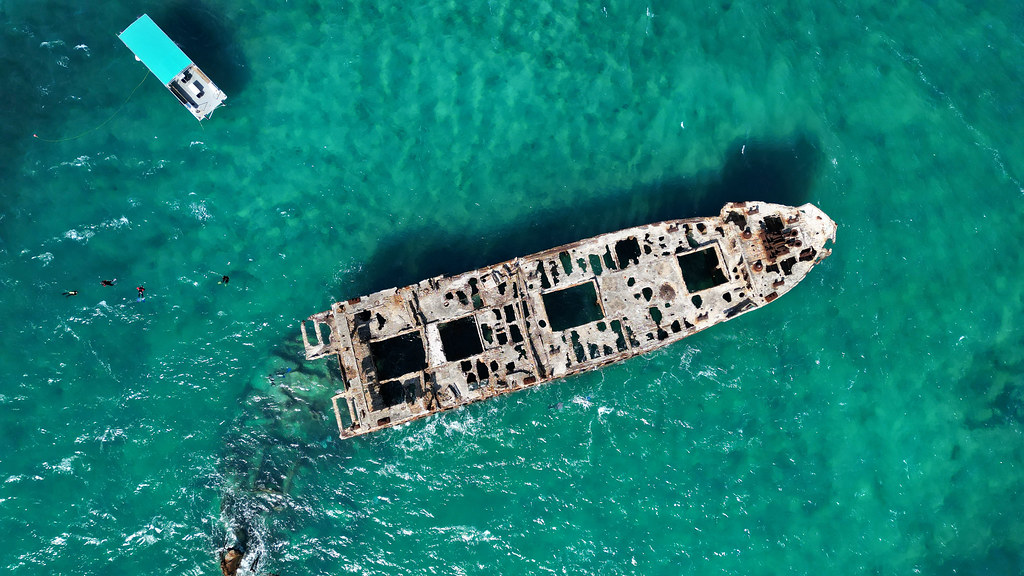The Caribbean Sea, with its crystal clear and warm waters, has been the scene of countless stories of navigation, trade and conflicts. Over the centuries, these waters have witnessed numerous shipwrecks, becoming a paradise for diving enthusiasts who seek to explore sunken ships and the marine life that thrives around them. In this article, we will take you on a tour of some of the best dive sites in the Caribbean to explore historical shipwrecks, combining the fascinating history of these ships with the wealth of marine biodiversity that surrounds them.

- RMS Rhone, British Virgin Islands
One of the most emblematic shipwrecks in the Caribbean is the RMS Rhone, located near the island of Salt in the British Virgin Islands. This British steamship sank in 1867 during a hurricane, and has since become an artificial reef that is home to abundant marine life. Divers can explore the well-preserved structure of the ship, which includes the propeller and parts of the hull, while observing species such as meres, barracudas and colorful corals that have colonized the shipwreck.
- SS Antilla, Aruba
Known as the “Ghost of Aruba”, the SS Antilla is one of the largest and most popular shipwrecks in the Caribbean. This German freighter was sunk by its own crew in 1940 to avoid its capture during World War II. Today, the shipwreck is located at a depth accessible to divers of all levels and is covered with sponges and corals, providing home to a variety of marine life, including parrot fish, eels and sea turtles.
- Bank Chinchorro Shipwrecks, Mexico
Banco Chinchorro, located off the coast of Quintana Roo, Mexico, is a biosphere reserve that houses numerous shipwrecks dating from colonial times to the 20th century. This atoll is known for its clear waters and shallow depth, which facilitates the exploration of the remains of Spanish, English and American ships. In addition to the history of these shipwrecks, divers can enjoy rich marine biodiversity, including nurse sharks, rays and a wide variety of tropical fish.
- SS Sapona, Bahamas
The SS Sapona is a unique shipwreck due to its concrete construction during World War I. It collapsed near Bimini, Bahamas, during a hurricane in 1926 and has since served as a diving and snorkeling site. Although much of the boat is above the water, divers can explore the submerged sections, which are inhabited by a variety of marine life, including tropical fish and corals.
- Shipwrecks of Granada
Granada, known as the “Island of Spices”, offers several shipwreck sites for diving enthusiasts. One of the most prominent is the MV Bianca C, an Italian cruise ship that sank in 1961 off the coast of Granada. Known as the “Titanic of the Caribbean”, this shipwreck is located at a depth suitable for advanced divers and is home to impressive marine life, including large shoals of fish, barracudas and vibrant corals.
- Shipwrecks of Cozumel, Mexico
Cozumel, a Mexican island in the Caribbean, is famous for its reefs and diving sites. Among the prominent shipwrecks are the C-53 Felipe Xicoténcatl, an old Mexican Navy ship intentionally sunk in 2000 to create an artificial reef. This site is ideal for divers of all levels and is inhabited by sponges, corals and a variety of tropical fish.
- Shipwrecks of Roatán, Honduras
Roatan, the largest of the Islands in the Bay of Honduras, is a popular destination for wreck diving. The Odyssey, a 91-meter-long cargo ship intentionally sunk in 2002, is one of the largest shipwrecks in the Caribbean and offers divers the opportunity to explore its extensive structures, which now serve as a home to corals, sponges and a variety of marine life.
- Shipwrecks of the Cayman Islands
The Cayman Islands offer several shipwreck sites, the most famous being the USS Kittiwake, an underwater rescue ship sunk in 2011 off the coast of Grand Cayman. This dive site is suitable for divers of all levels and offers the opportunity to explore the different decks and compartments of the ship, which are now inhabited by a variety of marine life, including rays, meres and corals.

- Shipwrecks of Saba
The island of Saba, known as the “Intact Queen of the Caribbean”, is a lesser-known but fascinating destination for wreck diving. Among its sites is the Tent Reef, where divers can explore the remains of ancient ships and enjoy abundant marine life, including reef sharks, turtles and a variety of tropical fish.
- Shipwrecks of the Dominican Republic
The Dominican Republic is home to numerous historic shipwrecks, including more than 65 Spanish galleons sunk on its coasts. These shipwrecks, dating from the 16th to the 18th centuries, offer divers the opportunity to explore colonial history and enjoy the marine biodiversity that thrives on these sites.
Marine Life in the Caribbean Shipwrecks
The shipwrecks in the Caribbean not only tell stories of past times, but have also evolved into vibrant underwater ecosystems. The submerged structures of these ships provide ideal surfaces for the colonization of corals and sponges, creating habitats that attract a wide variety of marine species.
Colonization of Corals and Sponges
After the sinking of a boat, the metal and wooden surfaces begin to be colonized by marine organisms. Soft and hard corals adhere to the structure, forming complex artificial reefs. Sea sponges, known for their vibrant colors and diverse shapes, also find in shipwrecks a favorable place for their development. This colonization not only beautifies the oxidized structures, but also establishes the basis of a food chain that supports numerous species.
Common Inhabitants of the Shipwrecks
The Caribbean shipwrecks are home to an impressive diversity of marine life. It is common to find tropical fish such as parrot fish, angelfish and butterfly fish, which add a spectacle of colors to the environment. In addition, larger species such as groups, barracudas and snaths patrol these sites in search of food. The cavities and nooks of the shipwrecks offer shelter to brunettes, octopuses and locusts, while the open areas are usually crossed by rays and, sometimes, nurse sharks.
Ecological Importance of Shipwrecks
Beyond their attractiveness for divers, shipwrecks play a crucial role in marine conservation. They act as artificial reefs that increase local biodiversity, offering substrate and shelter in areas where natural reefs may be degraded or absent. In addition, these sites can relieve the pressure on natural reefs by diverting some of the diving activity towards them, allowing natural ecosystems to recover and maintain their balance.

Considerations for Shipwreck Diving
Shipwreck exploration requires additional precautions. It is essential that divers are duly certified and have experience in this type of diving, since closed environments and the possible presence of unstable structures increase the risk. In addition, it is essential to practice responsible diving, avoiding touching or altering the structures and marine life, to preserve these unique ecosystems for future generations.
The Caribbean offers an unparalleled combination of history and biodiversity through its many shipwrecks. Each site tells a story, not only of the boat and its crew, but also of the resilience of nature in transforming human remains into oases of marine life. For diving enthusiasts, exploring these shipwrecks is an opportunity to immerse yourself in historical chapters while enjoying the richness and color of the Caribbean underwater ecosystems.